- Bees
- Chickens
- Cows
- Deer
- Donkeys
- Elephants
- Frogs
- Geese
- Horses
- Lobsters
- Pigs
- Rabbits
- Rats
- Seals
- Sheep
- Turkeys
Frogs

Frogs are members of the zoological class called Amphibia. Amphibians are cold-blooded vertebrate animals. There are 3,900 species of tailless amphibians (Anura or Salientia), including the frog and toad.
The earliest know frog appeared during the late Jurassic period, about 190 million years ago. Scientists believe that the oldest frogs developed jumping legs to avoid being eaten by dinosaurs.
All toads are frogs. Generally speaking though, when we talk about true frogs, we refer to members of the family Ranidae. When we talk about true toads, we refer to members of the family Bufonidae.
Frogs have two bulging eyes, long webbed hind feet for leaping and swimming and smooth or slimy skin. They generally prefer moister environments.

Toads have stubby bodies with short hind legs for walking, warty and dry skin and poison glands behind the eyes. They generally prefer dryer climates.
The physical distinctions between frogs and toads can get blurred sometimes and certain species even fall into both categories. It is possible to find a warty skinned frog that isn't a toad, or even a slimy toad.
Frogs are found everywhere in the world except in Antarctica. Most frogs are found in the tropics.
Frogs that live in cold regions go in hibernation when the temperature drops.
A frog's tongue is attached at the front of the mouth and is covered with a sticky substance which it uses to catch insects.
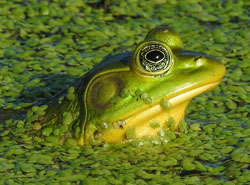
Most frogs breath through both their skin, mouth and lungs.
Frogs can hear using big round ears on the sides of their head.
The size of a frog will affect the sound of its croaks. Large frogs have deep voices and small frogs have higher voices.
Frogs swallow their food whole. When a frog swallows, his eyeballs will close and go down into his head applying pressure and helping to force food down their throat. Most frogs are carnivorous. They eat insects, worms, spiders and centipedes. Large frogs also eat mice and small snakes. There are a few herbivorous frogs. The Izecksohn's Brazilian Treefrog for instance eats brightly colored fruits and then later excretes the seeds.
Frogs don't drink, but absorb water from their surroundings through their skin (by osmosis).
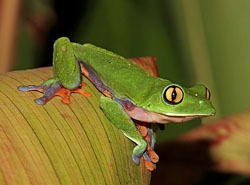
Tree frogs have adhesive pads on their toes which aid in climbing on the tips of the fingers and toes. Aquatic frogs have webbing between their toes that aid in swimming. Frogs that burrow into the sand to keep moist in the heat have stubby clawlike fingers that are adapted to digging. "Flying frogs" have parachute-like webbing on their hands and feet which act as an air-brake when they glide from tree to tree or leaf to leaf.
Frogs can range across very many colors. However, most frogs are dull in color to blend in with their environment. Some frogs can adjust their color according to changes in light, moisture, temperature, or even mood. Male and female frogs usually have the same color. You can distinguish between them by different markings and by the fact that only the males call.
Frogs have all kinds of enemies in the wild, including snakes, lizards, birds, small animals like hedgehogs, sharp toothed fish, swimming mammals and even other frogs.
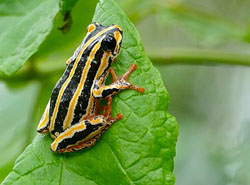
Most frogs blend with their backgrounds to avoid getting spotted by predators and some even change colors to match the backgrounds. Some frogs pretend to be dead when attacked. There are also frogs with flash markings. They show really bright markings just before they jump. When they land, the markings disappear and the predator will think the frogs is gone.
Frogs can live from 4 to 40 years, depending on the type. Most live between 4 and 15 years.
Frogs are good swimmers, but most will eventually drown if they don't have access to land.
Frogs lose water very fast in a totally dry atmosphere. They normally die within 3 hours.
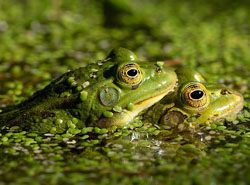
Frogs bulging eyes allow them to see in almost any direction.
When frogs mate, the male frog will climb on the female's back. They usually mate in the water and it can last for several days. The male frog will fertilize the eggs as they are laid. Some frogs will then leave, but others will stay to watch over the little ones.
Shortly after hatching, the tadpole will feed on the remaining yolk, which can be found in its gut. At this point the tadpole has poorly developed gills, a mouth and a tail and is very fragile. After 7 to 10 days, the tadpole will begin to swim around and feed on algae. After about 4 weeks, the gills start getting grown over by skin, until they eventually disappear. At this point they are fairly social creatures and some will even interact.
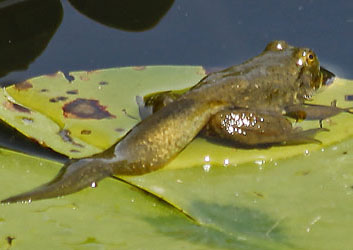
After about 6 to 9 weeks, they will develop legs. Their heads will become more distinct and their body elongates. They will now start to eat some dead insects and plants. Their arms will begin to bulge where they will eventually pop out, elbow first.
By 12 weeks, the tadpole has only a tiny tail stub and looks like a miniature version of the adult frog. By 12 to 16 weeks, depending on water and food supply, the frogs has completed the full growth cycle.



